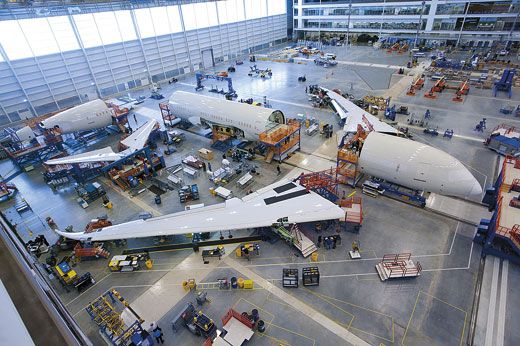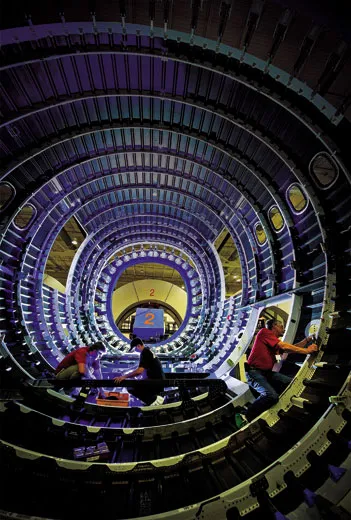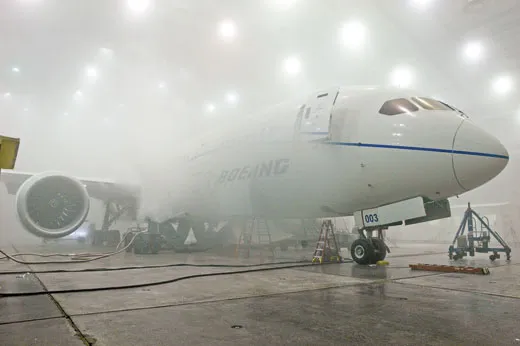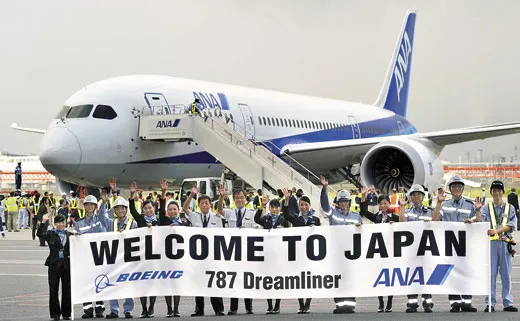Inside Boeing’s 787 Factory
The Dreamliner’s quiet revolution
/https://tf-cmsv2-smithsonianmag-media.s3.amazonaws.com/filer/Quiet-Revolution-airframe-FLASH.jpg)
I’ve been warned. “The cool factor in here is pretty awesome,” says Kim Westenskow, Boeing’s 787 factory superintendent, Position 4, as she escorts me to the assembly line in the company’s Everett, Washington plant. But that’s not the first thing that strikes you about this voluminous workspace, 380 feet wide and 10 football fields long. It’s the absence of industrial racket. The Dreamliner’s molded composite constituents are bolted together, and the holes are bored to the whir of air-driven, fluid-cooled, diamond-tipped drills. The aluminum 747 a few doors down requires drilling more than a million holes in metal, a process accompanied by ear-splitting fusillades of rivet guns and hammers. “They’re the other guys,” Westenskow explains. “The loud ones. We’re the quiet bunch.”
Between Position 0 and Position 4 on the line, disjointed wings and fuselage segments from around the world merge into a glossy white wide-body ready for the paint hangar and some major airline’s corporate livery. Westenskow enumerates the segments while extemporizing an atlas of global outsourcing: “Forward portion’s from Spirit Aerosystems in Wichita. Vertical fin’s from Boeing fabrication division in Tacoma. Tail cone’s from Japan, the horizontal stabilizer and fuselage segments are from Alenia in Italy.” The precision specs involved in 787 assembly impose upon Boeing’s worldwide partners a conformity undreamt of by the United Nations. With a passing glance, it’s impossible to distinguish 787 composite components cured in an enormous autoclave in southern Italy from those produced in the American heartland or at a Japanese aerospace giant.
Under the scrutiny of quality control engineers at Boeing, however, the contrasts have sometimes been stark. Alenia Aeronautica improperly torqued shims used to fill gaps in the airplane’s horizontal stabilizer. The errors threatened the component’s structural integrity, briefly halting 787 test flights in 2010. The year before, Boeing discovered that the skin of Alenia’s composite fuselage segments had wrinkles caused by internal stringers that were out-of-spec, necessitating patches to existing segments and design reworks for future production. While outside analysts report that Boeing is satisfied with Alenia’s improved performance over the past year, particularly the fuselage segments made in Grottaglie, the company maintains tentative plans to shift initial primary production of the stabilizer for the 787-9 variant back to Seattle.
From 2008, when he became 787 program manager at Boeing’s Everett, Washington factory, to February, when he handed off the job to Larry Loftis, all of those problems and more landed on the desk of Scott Fancher. By the time Fancher took over the project, the 787 was mid-season in an industrial soap opera. Fancher had spent his previous three decades with the company in its military divisions, working on staples including the F/A-18 Hornet and exotica like the airborne laser program. “It was a bit unusual for them to bring someone from the military business over to commercial,” he acknowledges, “so clearly I expected this was going to be a challenge.”
“Challenge” is one word for what confronted him. Overweight, over-budget, and overdue are others, with footnotes for striking unions, stressed-out customer airlines, and structural cracks. The 787 is in many ways a clean-slate departure from Boeing’s aluminum airliner fleet; its composite structure, intended to lower operating costs by reducing weight and therefore fuel usage, and features emphasizing passenger comfort, inherited from the Sonic Cruiser concept of the 1990s, had never before been built. The innovations turned the project into a saga of technical tribulation and continual organizational gut-checking. Now that the official EIS (entry into service) is history, expect some of that drama, and the thousands of aviation blog posts it spawned, to begin a slow fade. Though Fancher laughs when he remarks that most development projects in aviation “seem a lot easier after some time has passed,” he’s right. Few today remember the problems the now-sainted 747 faced: Engine faults necessitated grounding the first 20 production models for months, and recalling the airplane delivered to launch customer Pan Am.
At the assembly line’s present rate, 3.5 Dreamliners roll out each month. By contrast, in the same time span, Boeing produces 1.5 747s. By the end of next year, with additional production boosts, the planned addition of a “surge line” in Everett and production from Boeing’s Charleston, South Carolina assembly facility, every month 10 back-ordered Dreamliners will wing into the waiting arms of an airline. Only the 737 is produced in larger volume (currently 35 rollouts monthly).
In this economy’s low light, it looks like glimmers of job creation. But Boeing is cautious about projecting the 787’s employment potential. For one thing, as its novel construction process is tweaked, existing workers get more efficient. “As we improve at assembling this airplane,” Westenskow says, “we’ll actually need less people to build each one, not more.”
At Position 0, newly arrived composite components pause for 24 hours so their temperatures will stabilize. Tolerances for assembly are so tight that even minute variations—slight contraction caused by exposure to cold on the flight from a manufacturing center to here—can affect the process. At Position 1, the big pieces come together, Westenskow says: “All five at once: two wings and three fuselage segments.” The FBJ (Final Body Join) tool, a multi-tentacle jig, cradles the constituents and uses indoor GPS and laser measurement devices to mate them with automated accuracy. Position 2 finishes the electrical connections among the segments and installs the floors. Position 3 fits the interiors. Position 4 tests all functions.
The strikingly svelte 787 wing, displayed overhead in the jig that mates it to the fuselage, looks like a gallery exhibit. Westenskow points, tracing the aesthetically pleasing curve. Produced by Mitsubishi Heavy Industries in Japan, its carbon-fiber–aluminum hybrid structure is as mean as it is lean. Exactly how thin the wing is, Boeing won’t say. But Everett workers chosen to squeeze up into it must pass a physical qualifications test “which includes a very small hole,” Westenskow says. With line speed-ups looming, the wing join process is the key to making delivery commitments. If things slow down here, everything else stops.
It has happened before. Unlike aluminum airplanes with substantial spars spanning the connection between wing and fuselage, or wing join, the Dreamliner’s mostly composite wings bolt directly to the fuselage in a complex connection called the “side-of-body join.” Two years ago, stress tests revealed cracks in the center wing box (where each wing joins the airplane’s body inside the fuselage), bringing the vast project to a standstill for months. A time-consuming redesign to the fittings that support the connection at stringer (stiffening rods on each wing’s upper skin) attachment points was proved through exhaustive testing. Westenskow calls the team now implementing the modification at Position 1 “the best mechanics in the program.” That would be Erwin Arlantico and crew. They bear the sobering responsibility of attaching 787 wings.
Hard-wired for intensity appropriate to his job description, Arlantico rapid-fires remarks over one shoulder as I hustle to keep up with him. “A bad day on this project is any bad hole,” he says, pointing out the drill jigs clamped to the fuselage where the titanium wing fittings bolt. In constructing aluminum airliners, most holes Boeing made in a single shot. “But carbon fiber is a very different beast,” Arlantico says. Drilling each hole for the more than 500 fasteners that attach the wings is a three-step process, beginning with a small index hole and culminating in a final bore to excruciatingly tight specs. The relationship between the fuselage hole to the bolt hole in the wing mount fitting is non-negotiable: “Even 1/5,000th of an inch of misalignment,” Arlantico says, “and you won’t be able to fit the bolt in.” The carbon fiber structure is unforgiving of the slightest inelegance with high-speed, diamond-tipped drills. A minute elongation of the hole can sear the fiber, instigating de-lamination in the 150-layer, molded composite sandwich. Don’t bother asking what if. “We’d have to patch every single layer,” Arlantico says stoically.
Any number of interested parties monitors Arlantico’s crew as they go about this exacting and critical procedure. “Our customers are welcome to their airplane at any time,” Westenskow explains. With offices just steps from the Everett line, representatives of airlines with Dreamliners in assembly often inspect this team’s work. “All Nippon Airways is the toughest customer we have,” Arlantico remarks. “Very picky, very meticulous.”
Takeo Kikuchi, ANA’s general manager of the U.S.A. Engineering Office at Boeing, admits to high standards. “We don’t like to place pressure on the Boeing workers,” he e-mails, “but I do believe our presence reminds the workers that the customer is aware and watching their work.” Kikuchi and his team closely track the construction process and apply ANA’s acceptance standards to “every inch of the airplane.” Kikuchi is obviously proud of his company’s status as the 787’s launch customer; ANA took delivery of the first Dreamliner last September. “We provided input and had a great opportunity to help make the 787 a better airplane for ANA,” Kikuchi says, “which in turn makes it a better airplane for other airlines as well.” Boeing and ANA generally agree on concepts of safety and reliability, but opinion sometimes diverges over other points—for example, special reinforcements, or “doublers,” installed as part of custom reworks to address manufacturing issues on a given airplane. Though such reworks are allowed by the certification process, ANA has balked. “We don’t like to take a new airplane with any custom-designed structure or doublers,” Kikuchi explains. “Those are tough days, when we have to have these discussions with Boeing, as this can have schedule impact.”
Kikuchi is thoughtful about his role as man-in-the-middle between a major airline in Japan and Boeing’s corporate culture. “To be frank, [it’s] a great challenge,” he says. “Located here within Boeing, I understand what is truly going on here. The ANA team in Japan does not and often finds other things difficult to understand.” Kikuchi strives to make sure each party gets what the other is thinking.
As a Dreamliner progresses through the line at Everett, hundreds of people lay hands on it. But this workforce doesn’t look like the one you might encounter at final assembly of the aluminum airliners known as Boeing’s heritage fleet. On the 787 line, a conspicuously next-gen ambiance prevails: “Very, very young,” Westenskow says of her workers. “Very adaptive, very computer-literate, very able to communicate with engineering.” She laughs and adds, “Most of them couldn’t buck a rivet because most have never built airplanes that way.”
Scott Fancher, program manager at the Everett plant at the time of my visit, is proud of keeping attrition on the 787 relatively low compared with other programs’ staffing losses. “First of all, we can’t burn people out. We have to make sure they have healthy and robust family lives in addition to their work lives,” he says. Fancher says his 787 team, all the way to the rank-and-file on the line, stay cool under fire, and he attributes this to nature as much as nurture. “Certainly, we looked toward the best of Boeing to come work on this program,” he says. “But a natural selection process occurred too.” The intense flame surrounding development environments like the 787 drives off particular psyches while attracting others. Fancher strongly believes people who thrive on the cutting edge instinctively migrate toward it. In the case of the 787, many of those turned out to be new hires from outside, mentored by more experienced workers.
Standing in the center fuselage segment surrounded by Gunnar Lofstedt and his crew of electricians, I get the feeling I don’t listen to the same bands they do. I also have an impression of events running in reverse. Instead of installing stuff, they’re busily removing intricate wiring bundles. Elements of the 787 construction are still in continual flux. Triggered by data collected in ongoing test flights and early revenue service with ANA, “change incorporation” involves everything from simple tweaks of cabin entertainment to wiring. From the electrochromic window dimmers to the fly-by-wire flight controls, almost everything on the 787 is electronic, so the slightest engineering afterthought dictates changes in wiring. But in the Dreamliner’s modular construction scheme, fuselage segments arrive from the manufacturer already pre-stuffed with 60 miles of it—installed days ago. In 787 time, that’s so last week.
“We do data, we do everything,” Lofstedt says. “A single harness might go to 10 different systems.” One fiber optic bundle extends from nose to tail, over the crown in the ceiling, then down under the floor. The bundles of color-coded spaghettini look crazy-making enough as they thread along the bare fuselage wall; imagine fully extricating a built-in wiring harness from an assembled wide-body. Isolate a few strands, incorporate the change, then weave the bundles back through a warren of conduits, access ducts, and ceiling voids to all the right connectors, without bending certain cables beyond specs. It’s the hard way, but Lofstedt and his crew proved it’s easier and faster to change the wiring by pulling the harness than do it with the harness installed. “We can pull an entire wiring bundle out of the plane in one day and put it back in in two or three,” he says.
But nothing stops to wait for them. As a 787 moves down the line, it accumulates other crews installing components even as Lofstedt’s 24 electricians incorporate changes. Which begins to sound confusing. “It starts to get very crowded very fast,” Lofstedt confirms. They’ve lingered in the airplane making revisions as late as Position 4, the final stop before rollout. To buy more time, they now begin incorporating changes way back at 0.
Examples of design modifications to the 787 include several initiated by ANA’s input, such as the addition of an automotive-style spray window washer. Unlike most Boeing airliners, 787 cockpit side windows don’t slide open to permit the flight crew to clean the windscreen; they have to rely on airport ground workers. “We shared that we fly into some airports where no ground equipment is available to gain access to clean the windows,” Takeo Kikuchi says. “Boeing reviewed our request, looked at the data we shared, and added the system.”
Four floors up, the staff of the 787 Production Integration Center (PIC) have a commanding view of the assembly line. But it pales compared with the total picture of the process they get from the 10-foot-high, 40-foot-long video wall before them. Raw data relating to the production of 787 components around the world merges in the room like a confluence of swift-running mountain streams. It’s displayed in larger-than-life fashion to 25 “focals”—each a point person for a specific duty—occupying computer terminals in the PIC, 24/7. “We get involved in everything you can imagine,” says Tox Popnoe, the center’s energetic manager. “Anything that affects the production or the schedule of the 787 program.”
Seventy percent of Dreamliner components are outsourced to manufacturers worldwide. Kinks in the supply chain, mostly resulting, Boeing admits, from insufficient oversight or stress testing of its myriad suppliers, have plagued the program from the start. From fasteners to flight guidance software, from Foggia, Italy, to Charleston, South Carolina, delivery delays or component quality-control failures have incited increasingly hardball measures from Boeing, up to and including buying the under-performing partner outright and upgrading operations to Boeing standards. To monitor the health of the chain, the integration center eyeballs production of the larger components on which day-to-day assembly of the Dreamliner relies, from manufacture to installation.
The Integrated Production Visibility (IPV) software figuratively perches on the shoulders of makers of fuselage segments, wings, and other major structures. “We track our Tier One partners: the Japanese, the Italians, and the domestic partners,” Popnoe says. The IPV window displays a real-time pictorial representation of each supplier’s factory flow, from the beginning of production to the time the component ships. “It’s an incredible dashboard,” Popnoe says. “We can tell where all the problem areas are, regardless of geographic location. We know how many jobs they have to complete and whether they have any issues.” Color-coded graphs divulge all at a glance: Green is “on-plan,” yellow is off-plan by one to two days, red is off-plan by two days or more.
“Issues” is a big word in here. Any major one with a supplier manifests as a colored icon on a racetrack display with a 48-hour finish line. “A major issue is defined as anything that affects a shipment coming to final assembly,” Popnoe says. “Someone can call here 24/7 and say ‘Hey, I’ve got this engineering issue in Japan and we need help to ship this section on time.’ That’s when the red light really goes on.” As the icon moves down the timeline, people in the room hand off the problem to shifts around the clock until it’s resolved—and sometimes that must be done in just hours to avoid line delays.
The production trail and present location of every 787 in process at Everett shows up on a “chicken tracks” display on the video wall. Digital maps update the current positions of all four Dreamlifters, the radically modified 747-400s that transport major assemblies of the 787. The big airplanes are in frequent transit and, as production ramps up, will fly almost constantly.
To the people monitoring the progress of 787 components, a major earthquake is just one more issue. Popnoe points out a screen displaying seismic data worldwide. If a quake strikes near a 787 production facility, Boeing knows immediately. The urgency is not limited to potential shipment interruptions. Delicately calibrated equipment at sites producing the composite wing and other components is not exactly temblor-friendly. “Our quality requirement states that if a facility has calibrated tooling on the program and there’s a 5.0 quake within a 50-mile radius, we have to go in and verify the tooling is still properly calibrated,” Popnoe explains. Otherwise, misalignment could occur in fuselage segments or wing-to-body joins. With 35 percent of the 787 produced in quake-prone Japan, that’s a real concern, particularly after the March 2011 Tohoku earthquake and tsunami. (After the earthquake, production equipment was recalibrated at Mitsubishi Heavy Industries.) Hurricanes are also tracked here, and a news window keeps the integration center apprised of political uprisings or labor strikes around the world that might affect 787 final assembly in Everett or South Carolina.
Production data in the PIC pipeline flows both ways at Boeing. “People downstream know what work is coming at them,” Popnoe says. “And we assimilate it up to our leaders, who make the educated decisions about how to keep the project on track and on schedule.”
The first Dreamliner is carrying ticket-buying passengers. The airliner—which received the 2011 Robert J. Collier Trophy, awarded for the greatest achievement in aeronautics in America—is already sold out through 2019, and Boeing assembly lines are shifting into overdrive to turn them out at a rate outpacing any other wide-body in the industry. Today Fancher declares flatly, “We firmly believe the 787 represents the biggest sea change in commercial aviation since the introduction of the 707.” Feedback from the global traveling public is not yet in. But on a publicity tour flying various Japanese citizens’ groups to celebrate the first delivery to All Nippon Airways, Fancher got a sample of Japan’s take on its new airliner. Even in heavy weather, “thousands of people came out to see the 787 everywhere we went,” he says. During a stop at Yokohama, Fancher ducked into the terminal to grab a cup of coffee and was soon recognized by 787 fans. One woman approached excitedly with a little girl in tow, he recalls. Fancher marvels: “She said, ‘Please, can you take a picture with my daughter?’ This woman had driven three hours and stood out in a cold driving rain to see the 787.”
When I spoke to him in Everett, the program manager was still smiling over the airliner’s rock-star reception. But there was a production system to ramp up, 873 Dreamliners on back order to 60 customers around the world, and the next variant of the airplane in development already. As soon as delivery number one was in the hands of ANA, “we breathed a big sigh of relief,” Fancher reported. “For maybe three days. Then back to hard work.”
Frequent contributor Stephen Joiner writes about aviation from his home in southern California.



